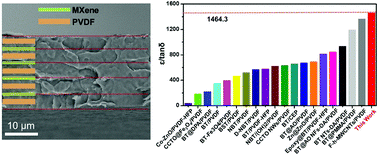Multilayer-structured transparent MXene/PVDF film with excellent dielectric and energy storage performance†
Abstract
Exploring polymer-based composites with a high dielectric constant and energy density simultaneously, as well as low dielectric loss, is of crucial importance because of their potential applications in modern electronics and electric power systems. Here, a multilayer-structured Ti3C2Tx MXene/poly(vinylidene fluoride) (PVDF) film with a high dielectric constant and ultralow dielectric loss is fabricated via spin coating, spray coating and hot-press methods. 4MXene/5PVDF (namely four layers of MXene and five layers of PVDF) exhibits a high dielectric constant (41) and an ultralow dielectric loss (0.028, smaller than that of pure PVDF) at 1 kHz. Surprisingly, the MXene/PVDF films show good broadband dielectric behaviors and the dielectric constant of 4MXene/5PVDF can reach up to 32.2 at 1 MHz, which can remain as high as 78.4% of that at 1 kHz. Based on the crystalline phase transformation and temperature dependence of electrical modulus results, the excellent dielectric properties are attributed to the enhanced interfacial polarization. The multilayered structure can efficiently prevent the formation of a conductive network across the entire film, leading to suppressed dielectric loss, a comparative breakdown strength with pure PVDF and a maximum discharge energy density of 7.4 J cm−3. This work provides a promising design paradigm to construct polymer films with a high dielectric constant and low dielectric loss.



 Please wait while we load your content...
Please wait while we load your content...